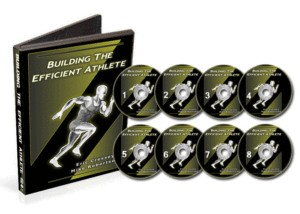The Law of Repetitive Motion
Back in early May, I published a newsletter discussing some alternatives I’ve used as replacements for traditional interval training. Basically, the goal was to show that one can work to address inefficiencies while still getting some good energy systems development training.
One of the key concepts I briefly outlined in this newsletter – and also thoroughly in Mike Robertson and my Building the Efficient Athlete DVD Set – is the Law of Repetitive Motion. This law is expressed as the equation I=NF/AR. In this equation, injury equals the number of repetitions multiplied by the frequency of those repetitions, divided by the amplitude of each repetition times the rest interval.
Looking at this equation and understanding each of these factors sheds some light not only on how we can prevent injuries, but also address these issues once they reach threshold. Truth be told, as I related in another previous newsletter, I’m a firm believer that we’re always just see-sawing back and forth, getting closer to threshold when tissues are loaded in excess of their capacity.
Providing adequate stability, mobility, recruitment patterns, and tissue quality with the appropriate training loads and recovery measures ensures that we stay below this threshold. All of these issues are covered in one way or another by the equation from above.
“I” is the injury, or insult to the tissues. In the active restraints – muscles and tendons – this may present in the form of soft tissue restrictions that can be addressed with manual therapy and foam rolling. In other words, sometimes simply doing some soft tissue work can bring someone back below threshold (one reason why I refuse to refer any athletes or clients to physical therapists who do not put their hands on patients, but that is a whole other newsletter altogether).

“N” is the number of repetitions imposed on the tissues. This may be working on a factory line doing the same motion over and over again. It may also be simply sitting with poor posture, which is the equivalent of a high number of reps (constant activation). Or, it could come from doing as many chin-ups as possible simply because your business partner told you that he didn’t think you could do it – and the Mudvayne in the background motivated you to action (but I wouldn’t know anything about that).
With respect to “N,” the general assumption is that simply reducing the number of repetitions is what it takes to reduce insult to the tissues. That’s absolutely true, but not exhaustively true.
Take someone who bench presses with the elbows flared, and teach them to tuck the elbows and activate the upper back and scapular stabilizers. You may instantly relieve their pain without altering the number of repetitions; you’re just redistributing the load.
The same is true of someone with anterior knee pain who has pain with forward lunging, but not with reverse lunges. So, the lesson to be learned isn’t just to modify the number of repetitions, but also the manner in which those repetitions are performed.
“F” is the force of each repetition, and it’s important to remember that this force is expressed as a function of maximum muscular strength. So, in other words, the “F” figure will be higher – and more injurious – on a weak tissue. This is one reason why resistance training is a big portion of modern physical therapy – including physical therapy that the brighter minds in the PT community wouldn’t consider “comprehensive” or “good.”
Here’s an example. Average Joe gets anterior knee pain and, of course, he gets diagnosed with patellar tendinitis when it’s really more of a tendinosis (but I won’t digress on that). He spends six weeks in PT to really “build up his quads.” It’s obvious that the patellar tendon was just weak and inflamed, so strengthening it and knocking back NSAIDs like candy will fix everything. Riiiiight.
Chances are that the patellar tendon was just overused because Joe had no hamstrings or glutes. Getting the quads strong just reduces the “F” figure in the equation above. They push him away from threshold, but not as far as he’d have gone if they’d also worked on recruiting glutes and hamstrings better, optimizing hip and ankle mobility, or performing soft tissue work. Or, maybe he just got better because they reduced the “N” we discussed above by resting the knee. Regardless, Joe’s not in the clear and very well might be back in PT in a few months if he doesn’t address the other issues in the equation.
And, with that in mind, I’ll get to the final two components of the Law of Repetitive Motion in my next newsletter. In the meantime, check out the Building the Efficient Athlete DVD Set for more details.
Related Posts
Rehab=Training, Training=Rehab: Top 10 Takeaways – Part 1
Rehab=Training, Training=Rehab: Top 10 Takeaways – Part 2
Sign-up Today for our FREE Newsletter and receive a detailed deadlift technique tutorial!



